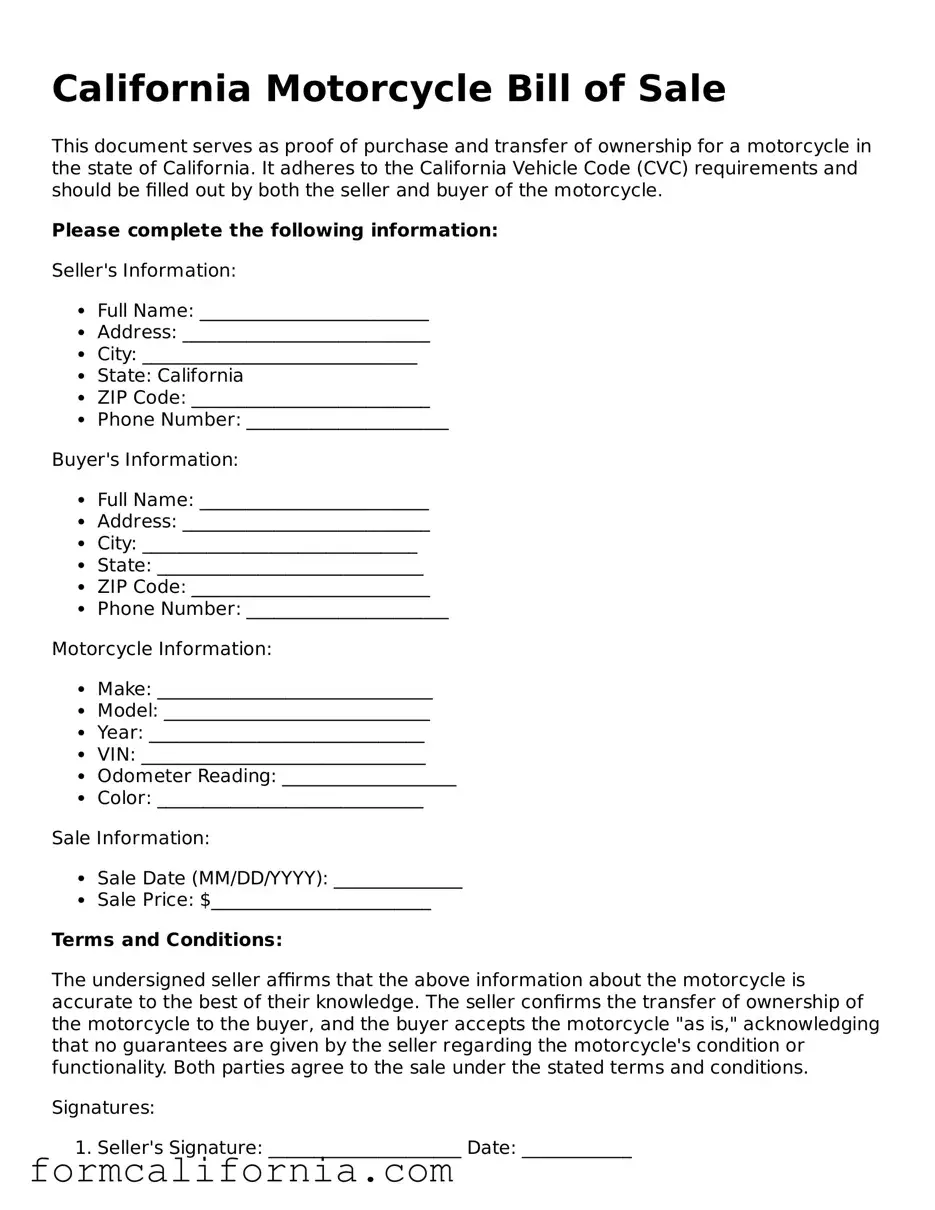The California Motorcycle Bill of Sale form is a legal document that records the sale of a motorcycle from one person to another within the state of California. This form provides evidence that a transaction took place, detailing the transfer of ownership, motorcycle specifics, and the terms agreed upon by both the seller and buyer. It serves as a receipt and can be used for registration and taxation purposes.
Why is it important to use a Motorcycle Bill of Sale in California?
Using a Motorcycle Bill of Sale in California is important for several reasons. Firstly, it provides legal proof of purchase and ownership, which is necessary for the buyer to register the motorcycle under their name. Secondly, it clarifies the terms of the sale, reducing the risk of future disputes between the seller and buyer. And finally, it serves as a record for tax purposes, which is essential for complying with state regulations.
-
Seller and buyer's full name and contact information.
-
Motorcycle description, including make, model, year, color, VIN (Vehicle Identification Number), and odometer reading.
-
Sale date and price.
-
Any warranties or "as-is" condition statement.
-
Signatures of both parties involved in the transaction.
-
A notarization section, if applicable.
Is notarization required for a Motorcycle Bill of Sale in California?
No, notarization is not a legal requirement for a Motorcycle Bill of Sale in California. However, having the document notarized can add an extra level of legal protection and authenticity to the transaction, ensuring that all signatures are verified.
You have the flexibility to create your own Motorcycle Bill of Sale as long as it includes all the necessary information listed above. While there is no mandated state form for motorcycle sales in California, creating a comprehensive and detailed document is crucial for both parties’ protection.
What happens if I lose my Motorcycle Bill of Sale?
If you lose your Motorcycle Bill of Sale, it's recommended to contact the other party involved in the transaction and request a copy. If that's not possible, you may draft a new document, including all details of the original sale, and have both parties sign it again. Keeping digital copies can help prevent such issues.
Do both parties need a copy of the Motorcycle Bill of Sale?
Yes, both the seller and the buyer should retain a copy of the Motorcycle Bill of Sale for their records. This ensures that both parties have proof of the transaction details, which is important for registration, taxation, and any potential future disputes.
How does a Motorcycle Bill of Sale protect the buyer?
A Motorcycle Bill of Sale protects the buyer by providing a documented proof of purchase and ownership transfer. It serves as evidence that the buyer has legally acquired the motorcycle and helps in resolving any future disputes over motorcycle ownership. Additionally, it assists in the registration process, which is essential for the legal operation of the motorcycle.
How does a Motorcycle Bill of Sale protect the seller?
The seller benefits from a Motorcycle Bill of Sale as it documents the transfer of ownership, releasing them from liability related to the motorcycle after the sale. This documentation is crucial in the event of any legal disputes or if the motorcycle is later involved in any legal issues, such as traffic violations or accidents, under the new ownership.
What steps should be taken after completing a Motorcycle Bill of Sale in California?
-
The buyer should use the Bill of Sale to register the motorcycle under their name at the local Department of Motor Vehicles (DMV).
-
Both parties should store their copy of the Bill of Sale in a safe place for record-keeping.
-
Consider consulting a legal professional to ensure all aspects of the sale are in compliance with California state laws.
